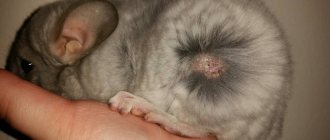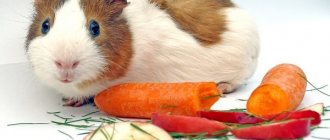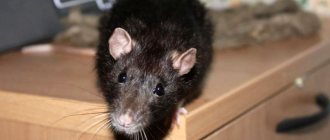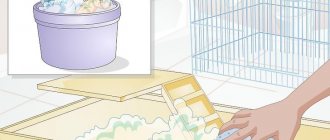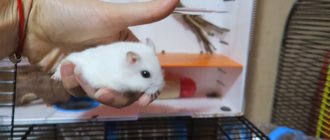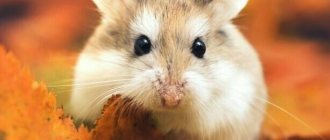- home
- Chinchilla
- Health
03/21/2019 The little chinchilla pleases its owners with its cheerfulness and funny character. But she also has problems. They can relate to such an unpleasant phenomenon as convulsions. It is important to learn how to provide first aid to your pet if there are signs of illness.
Chinchilla has diarrhea
The medical name "enteritis" is one of the diseases caused by poor diet. Chinchillas often “ask” for something tasty from fresh fruits or vegetables. But if you give animals a treat, stomach upset will inevitably occur.
Symptoms of the disease will be:
- softening of droppings;
- fur stained with feces;
- the appearance of an odor from feces.
Every chinchilla owner has encountered this disease. Therefore, the “what to do if a chinchilla has diarrhea” technique has long been worked out. First of all, the animal is put on a strict diet of hay and water. In this case, no grain or other food is given.
Since severe dehydration occurs with diarrhea, it is necessary to ensure that the chinchilla drinks. If the animal is very ill, you will have to force-feed it from a syringe. Instead of water, you can give a decoction of oak bark. It is not recommended to use pharmaceutical drugs without the supervision of a veterinarian due to the animal’s weight being too low.
If the veterinarian prescribed antibiotics, suspecting an infectious disease: salmonellosis, then after a course of treatment the chinchilla needs to restore the gastrointestinal flora. To do this, you will have to use the droppings of a healthy chinchilla, fill it with water, and, after infusing for 30-60 minutes, “give” the infusion to the sick animal. Bacteria released from the gastrointestinal tract along with droppings will quickly restore the intestinal flora of a sick chinchilla.
First aid
It is difficult for an ignorant person to expect an attack or predict its approach, but it is possible to be prepared for such a situation. The duration of the seizure or its course cannot be influenced. The goal is to prevent more severe consequences.
- Record how long the spasms and other noticeable manifestations last. Observe which muscles cramp the most: the front legs, the hind legs or the whole body.
- Try to prevent the dog from hitting objects, a wall, a tree, or falling down the stairs.
- Place your pet on the bedding.
- At the end of the seizure, gently stroke and offer water. You should not feed yet.
- Support your dog emotionally with care. She is confused and does not understand why this is happening.
- If a pain attack does not end for more than 10 minutes or after completion the pet does not come to its senses for more than thirty minutes, you need to call an ambulance or go to the doctor yourself.
Life-threatening convulsive syndrome - epistatus. The attack lasts 5-7 minutes and is repeated at intervals of less than 30 minutes. Requires immediate assistance.
It is forbidden:
- stick out your tongue, try to open or close your mouth;
- leaving your pet alone;
- It is advisable that during and after a seizure the animal is not frightened by loud sounds or irritated by strong and pungent odors.
Constipation
The disease is the opposite of diarrhea and often occurs in chinchillas due to eating dry food with a lack of water. Because of this, it is necessary to ensure that water is always freely available to animals.
Since a chinchilla cannot singe, over time the animal’s belly swells. Through the abdominal wall you can feel the intestines with hard feces. When constipation occurs, pain occurs, and the animal begins to take care, becoming lethargic and inactive. Chinchillas refuse food.
In this case, you can no longer manage with a simple diet. What to do if your chinchilla is constipated:
- several times a day, forcefully feed the animal 1-2 ml of liquid petroleum jelly;
- Vaseline oil enemas;
- make the animal move.
Vaseline oil is not absorbed by living organisms, passing through the entire intestine and covering the walls of the gastrointestinal tract with oil. This oil will not cause any harm. Movement improves gastrointestinal motility.
In advanced cases, chinchillas are given injections of Cerucal 0.3 ml twice a day.
On a note! It is very rare, but there are cases of constipation due to swallowed wool.
Typically, chinchillas do not swallow fur because they do not lick themselves like cats. But if the animals are poorly maintained, dead wool can get into the feed and be eaten. The second option for fur getting into the chinchilla’s gastrointestinal tract is a fight with another animal. If the intestines are really blocked by a hairball, you can use Malt paste. But to do this, you must first make sure that the disease arose due to fur and there are no other reasons.
Rabbits molt
They shed 2 or 3 times a year, but when the room where the rabbits live is well heated, they can shed all year round. At the same time, a healthy pet does not have any problems, but young fur quickly grows back in place of the lost one. It can even fall out in clumps, and bald spots form on the body. But if after a few days they begin to overgrow, then there is no reason to worry.
What to do during the molting period, how to help the rabbit so that it does not have health problems?
- The animal must be well combed. This will reduce the amount of loose hair that ends up in your rabbit's stomach. When they shed, they begin to lick themselves thoroughly, so the fur ends up in whole clumps in the digestive tract.
- You need to make sure your rabbit has plenty of hay. It pushes out the fur that has gotten there from the esophagus.
- It is worth taking a closer look at how the intestines work. If the rabbit behaves as usual, but the amount of feces has decreased, it has become dry, sticky, or fur is visible, then the animal can be given 5 or 10 ml of Vaseline oil. In the event that the pet begins to behave differently, begins to defecate less or stops doing it altogether, seek advice from a specialist.
Shedding is the natural process of changing fur in a rabbit.
Flatulence
This disease is a direct consequence of feeding succulent food to chinchillas by loving owners. Especially feeds with a high sugar content. In the animal's intestines, these feeds begin to ferment, releasing gas. Chinchillas are not adapted to excreting gases through the anus, which is why flatulence or bloating develops. Symptoms of this disease in chinchillas:
- firm round belly;
- pain when touching the abdomen;
- lethargy, the animal prefers to lie down;
- refusal of food;
- hard breath.
The latter may be a sign of another disease. You cannot cure bloating on your own. Treatment should begin as quickly as possible and only under the guidance of a veterinarian.
Poisoning
The disease occurs when feeding spoiled food. Symptoms of poisoning in chinchillas are very similar to signs of a foreign body getting stuck in the throat.
Poisoning:
- urge to vomit;
- lethargy;
- possible bloating or diarrhea;
- vomit;
- Foam and mucus flow from the animal’s mouth and nose.
When a piece of wood or other object that the animal used to entertain itself gets stuck in a chinchilla’s throat, the symptoms are very similar:
- gagging or vomiting;
- salivation;
- sneezing;
- mucus and foam from the mouth and nose.
It is very difficult to independently determine the cause of a chinchilla’s disease, so if such symptoms appear, the animal must be taken to a veterinarian as quickly as possible.
Urinary system disease
Cystitis usually affects adults. Both males and females are equally susceptible to the disease. The first signs of cystitis are problems with urination, anxiety, the animal bites its sides, squeaks often, and becomes inactive. If signs of illness appear, you should immediately consult a doctor. Self-treatment of the disease without prior examination can only harm the animal. Very often, the internal cause of cystitis is sand or even kidney stones.
Rectal prolapse
The disease is often a consequence of constipation and the animal’s attempts to cough or very intense diarrhea. This picture looks creepy: 1-2 cm of bloody rectum falls out of the chinchilla’s anus. If measures are not taken immediately, the intestine dries out in the air and the disease ends in tissue necrosis.
The intestine must be immediately lubricated with antibiotic ointment to prevent drying out and infection by pathogenic microorganisms. After which the animal is taken to the veterinary clinic. It is better if the chinchilla’s intestine is corrected by an experienced doctor.
Mastitis
If there are microcracks on the nipples of a whelping chinchilla, staphylococcal bacteria, the causative agents of mastitis, can penetrate through them. Mastitis usually occurs after whelping, although the disease can develop without whelping. Symptoms of mastitis:
- redness of the breast;
- elevated temperature;
- pain while feeding babies.
The disease is treated with frequent massages of the mammary gland, since it is unlikely that it will be possible to squeeze antibiotic ointment into the nipple. Size too small. If possible, you can try to milk the diseased gland.
Important! You cannot take away the cubs from a female, the situation will only get worse.
General injections of antibiotics of the penicillin group can help, but the antibiotic will get to the puppies with the mother's milk. Therefore, here every animal owner makes his own choice.
What other sounds does a chinchilla make and what do they mean?
General classification of sounds:
| Search engines | Very quiet melodic squeaks |
| Alarming | Loud in the form of yelping, quacks |
| Discontent | Hooting, buzzing |
| During sexual intercourse | Meow |
In addition, chinchillas make other sounds.
- If babies are hungry, they squeak loudly, trying to find their mother in this way to eat.
- While feeding her offspring, the female begins to grumble, the same sound comes when she licks their fur, thereby teaching them to be clean.
- If small pets are calm and well-fed, they make a signal that resembles cooing.
- When protesting, an annoying, angry, loud sound is made, similar to the yelping of a small dog. As a rule, such a reaction occurs when the animal is poorly cared for or caused pain by a person.
- Eating sounds are divided into chewing a dry treat or gnawing wood. And the expression of pleasure from eating food often resembles the quack of a duck.
- If the animal begins to grunt, this indicates its interest. More often, such sounds occur when sniffing each other, while walking around the room, getting to know surrounding objects, and when mastering the environment.
- A sharp, piercing sound means that the animal is aggressive towards its fellow tribesman or even its owner. If the sounds are simultaneously accompanied by loud grinding of teeth, this means severe irritation.
Are all chinchillas silent by nature?
There is a whole classification of chinchillas that divides these animals into their features and talkativeness:
| Silent people | This type of chinchilla is a quiet and taciturn animal; you may never hear a sound from them in your entire life. |
| Singers | Very sociable in childhood, they often “sing”, but with age they become quiet and can squeak slightly while walking or “swear” if they don’t like something. |
| Grumps | Since childhood, they make more and more grumbling sounds, expressing any feelings |
| Meowuns | As a rule, this group includes females during estrus, who, teasing the males, begin to meow protractedly and loudly, like cats |
| Squeakers | Individuals that squeak almost all the time |
| Eagle owls | They always make a quiet guttural sound, reminiscent of an owl's hoot, while the chinchilla's chest visibly shakes |
You can understand what your pet is talking about only by learning to distinguish sounds. Many special websites that contain all the information related to keeping chinchillas at home contain audio recordings of a wide variety of sounds that you can listen to. If you listen carefully, you can even find similarities in emotionality with human speech.
It is worth knowing that chinchillas can scream even in their sleep; this can be triggered by a strong smell or sound, a feeling of hunger, or due to poor sleep.
Be attentive to your pet and listen carefully to him, because he is practically a person, right?
Hair ring
A specific disease of males. A ring of fur sometimes forms on the penis, squeezing the penis. It is not difficult to determine the presence of such a ring:
- lethargy;
- refusal of food;
- lack of urination;
- upon examination, the penis is visible sticking out;
- the tip of the penis turned blue.
The ring must be removed as soon as possible. If the fur is “fresh”, the penis is lubricated with Vaseline or oil and the ring is carefully removed. If the fur has already dried to the penis, you will have to carefully cut the ring with nail scissors.
Hooks on teeth
These formations usually occur due to a malocclusion, when the teeth meet at the wrong angle. The disease is usually genetic.
Important! Chinchillas with malocclusion should not be allowed to be bred.
The second case of the occurrence of hooks is a lack of solid food in animals. Chinchillas' teeth grow constantly. This is a common feature of all actively gnawing animals. If the animal does not have the opportunity to grind down its incisors, the teeth grow and begin to injure the tongue.
If there is not enough solid food to chew or due to an incorrect bite, the back teeth can also grind down incorrectly, forming sharp edges that hurt the animal’s cheeks and palate.
Signs of hooks on a chinchilla's teeth:
- refusal of food;
- exhaustion of the animal in the absence of symptoms of other diseases;
- salivation.
A chinchilla breeder will not be able to cope with this problem on his own, since the hooks on the teeth must be removed surgically.
Reasons for refusing to eat
Some chinchillas are very picky eaters and may refuse to eat if the food is not fresh, monotonous, or the animal is not in the mood. Also, a furry pet may refuse the offered food in the hope of getting a more tasty treat. Animals often lose interest in food after experiencing stress. A new home, moving, visiting a veterinary clinic, or moving in with a new neighbor can cause stress. In this case, it is better to give your pet peace, talk to him kindly, and offer him his favorite treats.
However, in most cases, refusal to eat signals a health problem. The most common of them:
- Inflammation of the gastrointestinal tract (catarrhal),
- Heatstroke,
- Food poisoning,
- Problem with teeth
- Flatulence.
Catarrh
Catarrhal inflammation of the gastrointestinal tract can be of a cold nature, and also have an acidic or alkaline form.
Each form of the disease has some similar symptoms - refusal to eat, loose stools, accumulation of feces around the anus, lethargy. The cold form of the disease is characterized by yellowish feces; the chinchilla often sneezes and rubs its nose. With the acid form of inflammation, the chinchilla defecates very often, the feces have a sharp sour odor and are grayish in color. The alkaline form of inflammation is characterized by rare, but very loose stools that have an unpleasant smell of rot.
Treatment of the disease depends on the form of inflammation. Acid catarrh is treated with Syntomycin, which is given twice a day, 0.2 grams. A decoction of oak bark and a one percent tannin solution are also recommended. Alkaline catarrh is treated with drops of Salol, which are instilled into the animal’s mouth. A weak solution of ordinary potassium permanganate also helps. The cold form of the disease is treated with Biomycin. It is given twice a day, 0.2 g. It is also necessary to use nasal drops - one percent Furacilin or a 33% aqueous solution of Ecmonovocillin.
Any form of catarrhal inflammation requires a strict diet for the animal.
It is necessary to exclude everything except fresh and clean hay, as well as water. When the animal’s condition has returned to normal, they begin to give grated carrots, chopped oats and oat decoction. After this, regular feed is introduced.
Poisoning
Poisoning in a chinchilla can be caused by too salty food or toxic substances getting into the food. These include both poisonous herbs and various nitrates and other pesticides. Salt poisoning is characterized by refusal to eat, loud grinding of teeth, excessive salivation, severe thirst, and loose stools. The chinchilla becomes lethargic and refuses to make contact with its owner. Sometimes salt poisoning is accompanied by paralysis. Treatment for salt poisoning involves drinking milk or natural vegetable oil through a syringe. It is also necessary to administer 5% calcium chloride subcutaneously:
- For young individuals - one milliliter,
- Adults - three milliliters.
Poisoning can also occur as a result of eating poisonous grass or canopy, mold and rot along with hay.
Symptoms of poisoning vary depending on the amount of poison that enters the animal’s body. The most dangerous is severe poisoning, in which the chinchilla dies within two to three hours after feeding. Symptoms are severe diarrhea with a lot of blood, drooling, bloody discharge from the mouth, foam, refusal of food and water, convulsions, heavy and hoarse breathing. In case of acute poisoning, animals experience diarrhea or constipation (depending on the poison), bloating, the animal has poor coordination in space, and frequent convulsions appear. Poisoning can also be chronic. Symptoms are observed within one to two days:
- Refusal to eat
- Apathy,
- Pale mucous membranes,
- Loss of shine in fur
- The animal is rapidly losing weight.
For successful treatment, the source of the poison entering the chinchilla’s body must be determined. In the first hours after the onset of symptoms, it is recommended to give the animal strong emetics (Anamorphine) or laxatives, and also be sure to rinse the stomach. For washing, use ordinary warm water, in which crushed charcoal (you can use activated) charcoal is dissolved. Flax seed decoction, milk or any dairy products also help well.
Poisoning is always accompanied by severe dehydration, so it is necessary to monitor the constant presence of water in the drinking bowl.
If the pet does not drink, it is given artificially from a syringe every hour.
Dental diseases
Most often, a chinchilla does not eat due to dental problems. Hooked teeth or malocclusion is a common and common disease not only in chinchillas, but in all rodents. First symptoms:
- Poor appetite or refusal to eat,
- Fast weight loss,
- The animal chews each piece of food for a long time and thoroughly,
- Selects only the smallest and softest pieces,
- Profuse salivation
- Inflammation of the tissues of the lower jaw.
A more serious stage of the disease is accompanied by lethargy, copious discharge from the eyes and nose.
The cause of the problem is a genetic predisposition to improper placement of molars in the oral cavity. This leads to improper grinding of the molars - the rubbing surface as a result of such grinding comes into contact with the grinding surface of another tooth at an acute angle. Long and very sharp hooks form on the surface of the tooth, which injure the delicate mucous tissue of the cheeks, palate and tongue. This causes severe pain to the animal and makes it difficult to chew and swallow food.
When the disease is advanced, the pet loses more than ten percent of its weight, bowel movements become rare and are often in the form of very loose stools, the animal constantly rubs its muzzle and tries to get something out of its mouth, often yawns, and shows restlessness.
Treatment is carried out by removing or filing the hooks. If the disease is advanced, then the correction must be repeated every 4 - 5 months until the bite is completely restored. The procedure is carried out only in a veterinary clinic and under anesthesia.
Flatulence
Bloating in chinchillas usually occurs when too much green and juicy food is included in the diet. Green feed (especially legumes - clover and alfalfa) cause strong fermentation and gas formation. The disease is also accompanied by noisy and difficult breathing. Characteristic cramps are heard in the tummy. The pet becomes lethargic and refuses food and water. In more rare cases, flatulence leads to cramps. After convulsions, the chinchilla’s body temperature drops sharply to a dangerous 34.5 degrees. Young and weak animals may die at this moment.
Treatment of flatulence involves the use of adsorbent drugs:
- Espumisana,
- Carbolena,
- Activated carbon.
Magnesia and antibiotics have also proven themselves well: Etazol and Norsulfazol. They are given in 45 - 50 grams. You can also give Biomycin - about 20 grams. When treating flatulence, it is necessary to force the animal to move, since usually a sick chinchilla prefers to sit or even lie down. Movement is necessary to restore bowel function. A tummy massage, as well as an enema with warm and slightly soapy water, will also help.
On the first day after symptoms of the disease are detected, all hay and any remaining feed are removed from the feeders, leaving only water. On the second day, if the dynamics are positive, you can give the animal a little hay. On the third day - a little hay and granulated food.
Heatstroke
Keeping your pet improperly or living in a hot climate can lead to heat stroke. Overheating of the chinchilla's body is accompanied by:
- Lethargy,
- Refusal to eat
- The animal doesn't drink
- Breathing and heart rate increase,
- The mucous membranes become pale.
Severe overheating can also cause convulsions, animals fall on their sides and lose coordination of movement.
Severe heat stroke can cause the death of an animal.
First aid is to move the chinchilla to a cool, shaded place with good ventilation but no drafts. You can place a damp, cold towel on your head. If heat stroke causes convulsions, it is necessary to give an intramuscular injection with a caffeine solution - no more than two milliliters, and in case of heart problems, no more than two milliliters of twenty percent camphor oil and about twenty milliliters of a twenty percent solution of ordinary glucose are injected subcutaneously.
Conjunctivitis
Poor maintenance can cause animals' eyes to become clogged with dust or irritated by mold spores. Conjunctivitis can be either mechanical or infectious. With mechanical damage, a speck of dust gets into the eye and the animal’s tears begin to flow.
Interesting! Tears are a protective mechanism against mechanical irritants of the eyes.
What to do if your chinchilla's eyes are watery:
- check for debris under the eyelids;
- rinse eyes with saline solution;
- apply antibiotic drops.
If there are no specks, but your eyes continue to water, this is most likely the beginning of an infectious disease. In this case, it is better to go to the veterinarian to find out the reasons, while the inflammation is still weak and the eye has not festered.
A more severe form of conjunctivitis is purulent.
Very often this is a sign of a general infectious disease resulting from hypothermia and weakened immunity. Local diseases caused by pathogenic microorganisms include inflammation of the lacrimal canal. This disease is usually closely related to the malposition of molars. If an animal constantly develops hooks on its back teeth, you must be prepared that sooner or later the tear duct will also be blocked.
On a note! When the tear duct becomes inflamed, not only the eye festers; purulent discharge also appears from the animal’s nose.
What to do if a chinchilla’s eye festers:
- Before examining the veterinarian, carefully wipe the animal’s eyes with a decoction of calendula, chamomile or other suitable infusion;
- go to the veterinary clinic to determine the cause of the disease;
- follow your doctor's recommendations.
Self-medication here can only do harm, since in case of a general illness it is not the symptoms that need to be treated, but the cause. And if the tear duct is clogged, it will be difficult for the chinchilla breeder to clear it due to the small size of the animal. In addition, tooth extraction may be required.
Causes of seizures
Why do seizures occur? A cramp is only a symptom of a more serious illness. There may be several reasons that cause spasm:
- Epilepsy. This is the most common disease in dogs, associated with impaired brain activity and causing seizures.
- Metabolic dysfunction. These may include: hypoglycemia, eclampsia, hyperkalemia.
- Infection. Various infectious agents can cause spasms: fungus, bacteria, toxoplasmosis, infectious peritonitis.
- Neoplasms. Tumors that affect brain activity.
- Intoxication.
- Heart disorders.
Types of seizures
After the reasons that cause cramps, it is also worth mentioning the types of cramps. First of all, convulsions can occur in the hind and forelimbs, as well as the whole body.
Veterinarians distinguish several types of uncontrolled muscle contractions:
- Convulsions. During convulsions, the animal remains conscious and often does not experience pain.
- Tonic. Periodic, slow contractions during which the animal experiences pain.
- Clonic. Muscle spasms, the attack of which lasts from 30 seconds to 3 minutes.
- Epileptic seizures. The dog loses consciousness and his whole body goes into a seizure. Accompanied by copious amounts of foam at the mouth (saliva).
Hind leg cramp
It is worthwhile to dwell in more detail on limb cramps and the reasons for their occurrence, because their origin and symptoms may be a consequence of the development of more serious diseases. You cannot start them, as this can greatly complicate the treatment. If your pet's hind legs twitch, this may be a sign of both neurological and physical disorders. With spasms of the hind limbs, the animal may jump up, howl, the paws may be uncontrollable, and may twitch without causing pain. In any of the manifestations, the animal does not control its actions.
After the attack is over, the dog should be taken to the vet immediately. Get all tests done. Including genetic and infectious diseases. It is necessary to take an x-ray of the posterior spine and paws. An experienced doctor will be able to make the correct diagnosis and prescribe appropriate treatment.
Front paw cramp
Like cramps in the hind paws, cramps in the front paws can be a consequence of various neurological diseases or a manifestation of diseases of the joints or muscles. Very often, if a four-legged animal begins to have spasms in the front legs, then the limbs, at rest, can twist and twitch. This may cause a lot of stress on them. If the dog is a miniature breed, for example a Pekingese, then they have very serious joint problems and spasms in the front legs can be a manifestation of this physical disease.
Whole body spasms
No matter how sad it may sound, if a dog is having convulsions all over its body, then this is most likely an attack of epilepsy. Epilepsy is a serious disease, and at the first manifestations of it, the animal must be taken to the doctor.
The dog loses consciousness and goes into spasms. Her body involuntarily contracts for up to 3 minutes. During this time, the airways are blocked, it is difficult to breathe, profuse salivation occurs, as a result of which a white bubbly mass of saliva and air can form at the mouth - foam at the mouth. All this can greatly frighten the owner. Do not forget that timely consultation with a doctor will help in the further treatment of the animal.
How to treat a runny nose in a chinchilla
If we exclude the above cases of mucus from the nose, a runny nose in a chinchilla may occur as a result of hypothermia. In this case, the body’s defense systems weaken and the animal gets sick with what is commonly called a cold. In fact, this is the activation of certain pathogenic microorganisms when favorable conditions occur.
Symptoms of the disease will be:
- sneezing;
- body temperature is above 38°C, while the normal physiological temperature in chinchillas is 36.1-37.8°C;
- runny nose;
- general depression of the animal.
Often the very first sign of the disease is sneezing. But sneezing can be a simple reaction to dust or some irritating odor. If the animal sneezed a couple of times and stopped there, you don’t have to worry.
But if the animal sneezes a lot, it is necessary to take action. What to do if your chinchilla sneezes:
- to measure the temperature;
- clean the cage thoroughly;
- If the animal's temperature is elevated, contact your veterinarian to prescribe a course of treatment.
Given the general fragility of these animals, the first thing to do if your chinchilla gets sick is to contact a veterinarian. Provided that you can find a specialist in these rodents. Otherwise you will have to act at your own peril and risk.
A runny nose can also be caused by an allergic reaction to any irritant. Allergens are difficult to identify even in humans, so in the case of a chinchilla, the easiest way is to completely change the bedding and food and thoroughly wash the cage. But most often the problem is mold fungi found in low-quality hay.
Muscle Cramps: The Overwork Theory
Control of body position in space and control of muscle function are carried out using a variety of proprioceptors - sensory receptors. In particular, each striated muscle is equipped with special receptors - muscle spindles. They are located inside the muscle parallel to the normal (extrafusal) muscle fibers. Each muscle spindle is composed of different types of intrafusal muscle fibers. It is approached by blood vessels and nerve fibers: one type Ia afferent fiber and one or more type II afferent fibers, together representing a system of afferent innervation: from the periphery of the body to the central nervous system (CNS). The efferent innervation system (from the central nervous system to the periphery) of the muscle spindle consists of gamma motor neurons. The purpose of the muscle spindle is to inform the central nervous system about mismatches between the stretch of extrafusal and intrafusal muscle fibers, which allows control of muscle contraction.
Human tendons are protected from excessive stretching by other proprioceptors - the Golgi tendon organs. Most of them are located at the junction of tendons and muscles. The Golgi tendon organs are located in series with the muscle and are innervated by Ib afferent neurons. Some of them are associated with muscle spindles and work in conjunction with them.
Golgi tendon organs respond poorly to passive muscle stretching. They are mainly focused on controlling tendon stretching during active contraction of skeletal muscles. This changes the position of the collagen fibers attached to the muscle fiber. This leads to deformation of the nerve endings located in the Golgi organ, and, accordingly, to a change in conductivity on their membranes - that is, to the formation of a generator potential. The amplitude of the potential depends on the initial state of stretch and on the frequency of stimulation of the fiber.
The generator potential propagates along the nerve fiber and initiates an action potential (presumably in the area of the node of Ranvier), through which the inhibitory neurons of the spinal cord are excited. These neurons directly or indirectly form synapses with several types of motor neurons, which allows you to turn off muscle contraction at the right time and avoid overstretching. Thus, changes in muscle length are controlled by muscle spindles, and the level of their tension is controlled by Golgi tendon organs.
With intense physical activity, accumulating fatigue, incorrect posture, and shortened muscles, the work of proprioceptors can be disrupted, which leads to the development of muscle spasms. According to one hypothesis, as a result of intense physical activity, afferent activity of the muscle spindle increases significantly. This leads to a limitation of the braking processes triggered by the Golgi tendon organs. As a result, the control system over alpha motor neurons that innervates the muscle fibers of skeletal muscles is disrupted. That is, the mechanism designed to inhibit the processes of muscle contraction in response to physical overstrain stops working.
Seizures in a chinchilla, what to do
A fairly common disease in chinchillas, with various causes. Due to the fact that seizures can occur for various reasons, their treatment and prevention are also carried out using different methods.
Signs of seizures:
- sometimes seizures begin suddenly, but there are cases when the animal shows increased activity before the attack;
- directly during an attack, the chinchilla falls to the floor, shakes, and its head may throw back.
Seizures can hardly be confused with any other disease.
Causes of seizures and ways to stop them:
- hypovitaminosis: lack of B vitamins. Introduce a small piece of very dry dates or raisins into the diet (1-2 berries per day);
- hypocalcemia. Take a course of calcium gluconate and add yogurt to your diet;
- hypoglycemia. Increase the calorie content of feed or start feeding young animals;
- stress. Eliminate irritating factors and administer sedatives;
- epilepsy. The use of special medications prescribed by a doctor;
- spinal injury. It cannot be eliminated, it can only be prevented. If you don't drag the animal by the tail too harshly.
When caught by the tail, you can damage the animal's spine and thus provoke seizures.
First aid for seizures:
- warm up and calm the animal;
- inspect the chinchilla for any external damage;
- give an injection of dexamethasone in a dose of 0.1 ml;
- give the chinchilla 1 pc. raisins or a piece of date when the animal comes to its senses;
- take the animal to a veterinary hospital for examination.
But the measures only help if the chinchilla’s disease is not congenital and the spine is not damaged.
Diseases of other organs and systems
Jaundice
This is a sign of liver inflammation or problems with its functioning. The body cannot cope with the processing of vitamin A and carotene, which is why the animal’s fat takes on a yellow tint. It is impossible to completely cure a sick rodent. For prevention, B vitamins are regularly added to the fluffy’s diet.
Cystitis
Due to hypothermia, the rodent begins to behave extremely restlessly and go to the toilet more often “small times”. Sometimes the urine is stained with blood. In the first stages of the disease, Sulfamethoxazole and Trimethoprim will help (dosages will be prescribed by a specialist). If the disease has become chronic, then you should rush to see a veterinarian.
Chinchilla has fleas, what to do
One of the advantages of chinchillas over other pets is that these rodents do not have ectoparasites. Chinchilla fur is so thick that fleas or ticks cannot get close to the animal's body. The animal stops attempts of insects to crawl onto the fur with sand baths.
Interesting! A chinchilla has 60-70 hairs from each hair follicle.
If a chinchilla itches, then the reason is not fleas, but pododermatitis or allergies. The fleas jumping around the apartment did not come from an animal, but from the entrance, basement or through a window. It is necessary to disinfest the apartment, and ideally also the entrance, basements and neighboring apartments.
Even if the chinchilla was taken from very poor conditions and the animal lost a significant part of its fur, so that fleas were able to settle on the rodent, it’s okay. It is enough to treat the chinchilla with the same drugs that are used to kill fleas on other pets.
The main parasites of chinchillas
There are several types of ectoparasites that are found in chinchillas.
Fleas
These wingless insects jump high and cling to animal fur with their claws and bristles. The flea's body length ranges from 1 to 5 mm, and its mouthparts are designed to pierce the host's skin and feed on blood. They carry pathogens of dangerous diseases such as typhoid, plague, and hepatitis.
Chinchillas can become victims of cat, rabbit and rat parasites. When infected with fleas, the animal itches, hair falls out, and bites resembling warts appear near the face and on the limbs. Insects can be detected by parting the fur.
Lice and lice eaters
Both types of parasites live in the fur of mammals; the sizes of individuals vary from 0.5 to 10 mm. Lice feed on blood, and lice eaters feed on blood and skin particles. They reproduce quickly, laying white eggs - nits that stick tightly to the hair.
These insects also carry infections that are dangerous to people and pets. Their bites cause severe itching and anxiety in animals, as well as scratching on the skin.
Ticks
Chinchillas are parasitized by subcutaneous and ear mites that live in the upper layer of the epidermis. Because of them, bumps, peeling and crusts appear on the skin, the animal often itches and experiences severe discomfort.
The diagnosis is made after microscopic examination of the scraping. Curing a pet from ticks is quite difficult and is often possible only in the initial stages: first, the animal is cut, then washed in a 0.5% bromocyclene solution 4 times at intervals of 8 days.
Pododermatitis
When the skin on the soles of the paws is damaged, pathogenic bacteria can enter the wounds and cause inflammation. Signs of pododermatitis:
- severe itching;
- the animal bites its paws;
- anxiety;
- possible refusal of food;
- in the later stages, ulcers, calluses and corns appear.
Pododermatitis is relatively easy to treat, but treatment must be approached carefully. The wounds are washed with chlorhexidine 3-4 times a day and lubricated with antibiotic ointment.
Important! The animal must not be allowed to itch.
Injuries
Your pets are very active and mobile animals, which is especially noticeable when placed in one cage or during the mating period. During the mating games of animals in the cage, everything literally turns over, so injuries can occur, especially if the feeders and drinkers are not secured securely enough. When the animals are boarded, at first they sort things out quite vigorously, which can also lead to undesirable consequences.
Injuries include:
- bites;
- abrasions;
- scratches;
- dislocations;
- fractures.
In case of abrasions and scratches, the damaged skin is treated with hydrogen peroxide or chlorhexidine. Subsequently, they are lubricated with syntomycin or streptocide emulsion. In case of severe injuries, the victim is removed to ensure maximum rest.
In case of dislocations or fractures, it is better not to try to help yourself. It is necessary to contact a specialist as quickly as possible. For open fractures of the limbs, amputation is usually performed.
Why does a chinchilla shed, what to do?
And again a myth. Normally, chinchillas do not shed. But they can lose hair as a result of:
- stress;
- hypovitaminosis;
- allergies;
- lack of nutrients when feeding young animals;
- fungal diseases.
If it suddenly seems that your pet chinchilla is shedding, the animal should be urgently taken to a veterinary hospital for a diagnosis. Fungal diseases are dangerous because they affect people.
Since all skin diseases are very similar in appearance, only a veterinarian can tell you specifically what to do if a chinchilla’s hair falls out. In this case, you should not engage in self-diagnosis and treatment.
To prevent fungal diseases, you can add 1 tsp to bathing sand. Fungistopa. The drug is harmless to chinchillas, but suppresses the development of fungi.
Causes of hair loss
The chinchilla is an unpretentious animal and usually brings only joyful troubles to its owners. Clean, neat animals have a funny and cute appearance. It does not leave fur behind, unlike cats and dogs.
But this does not mean that they never shed. This process is ongoing for them. But no more than two dozen hairs can fall out per day, so shedding is invisible. Inconspicuous hairs can be seen on the bedding in the cage. An intensive molting process occurs during the period of change from children's fur to adult fur.
Stress
Experiencing a stressful situation can cause hair loss. Chinchilla is an emotionally and mentally very vulnerable animal. They have increased sensitivity to any changes in their lives. They do not tolerate moving, new people well, and are wary of new objects. They have a hard time experiencing forced separation from their owner and the death of other pets.
Stress causes fur to shed in clumps, which quickly leads to bald patches. The problem can only be solved by creating a calm environment for the animal.
Your favorite one needs to be given attention and affection, and treated with treats. Household members do not need to raise their voices in the presence of a rodent
This measure will definitely work. Within a few days the hair will stop falling out.
Avitaminosis
With an unbalanced diet, when the rodent is given few fresh fruits and vegetables, as well as during the winter and spring periods, the chinchilla may develop vitamin deficiency.
At risk are young animals, females bearing offspring and older animals. If vitamin deficiency is in an advanced form, bald areas of the body turn red, begin to itch and peel.
The issue is resolved by the following measures:
- Enrich the rodent's diet with foods containing vitamins A, C and D. Carrots, pumpkin, celery, and tomatoes are rich in carotene. Sweet peppers are the record holder for vitamin C content. D contains barley in large quantities.
- Freshly cut hay from meadow grasses (timothy, meadow fescue, sudanese, wheatgrass) should be present in the diet constantly.
- It is necessary to put mineral stones in the cage.
- An intensively shedding animal needs to add the vitamin preparation Multitabs to the water (1 drop per 100 grams of water).
Chinchilla owners sometimes try to inject vitamin preparations intramuscularly. This process is very painful. You can get the opposite effect: the chinchilla will shed due to the resulting stress.
Salmonellosis
An infectious and dangerous form of enteritis even for humans. Infection occurs through food and water contaminated with feces of sick animals. The main symptom of this disease is diarrhea. It usually occurs in two forms: acute and chronic.
The development of the acute form occurs very quickly, with profuse diarrhea. As a result of exhaustion and dehydration, the animal dies. Young animals can die even without visible signs of illness.
In the chronic form, diarrhea is replaced by normal feces. But the animal gradually becomes exhausted and dies. In both forms, the disease very rarely ends in recovery, so prevention is much more important.
Suspicious animals are separated from the main herd in quarantine. Apparently healthy chinchillas are tested for resistance. But for a pet, the chance of becoming infected with salmonellosis is quite small. This danger awaits animals on chinchilla farms.
Rabies
Many people have heard that the main carriers of such a dangerous disease as rabies are wild foxes and squirrels. Accordingly, people have a natural question: “Do chinchillas have rabies?” Maybe they should get annual vaccinations?
Theoretically, all mammals are susceptible to rabies. In practice, the virus is transmitted strictly from saliva into the blood of the next victim. Rabies is not carried on shoes, clothing or paws. They cannot be contracted through the urine or feces of a sick animal. A bite is required.
Chinchillas don’t go for walks; they simply have nowhere to meet a rabid animal. Even if a chinchilla manages to find problems for itself, the size of this animal is similar to that of a rat. And the rat is a natural food for the main predators that carry the virus. In other words, the chinchilla will not survive the encounter with a rabid animal in any case and will die before it gets sick.
Therefore, we can say with confidence that chinchillas do not get rabies. Unless you infect them on purpose.
Hypothermia and colds
Thick and dense fur perfectly protects from the cold, but the absence of sweat and sebaceous glands leads to the fact that wet fur immediately loses its properties. If your pet gets wet, you should immediately wrap it in a soft towel and place it in a warm place until it dries completely.
We must remember that your pet is extremely sensitive to hypothermia and drafts. A cold for these animals often ends in death, since bronchitis and bronchopneumonia develop very quickly against the background of hypothermia.
At the first signs of a cold (sneezing, runny nose, difficulty breathing), an urgent visit to the veterinarian is necessary.


